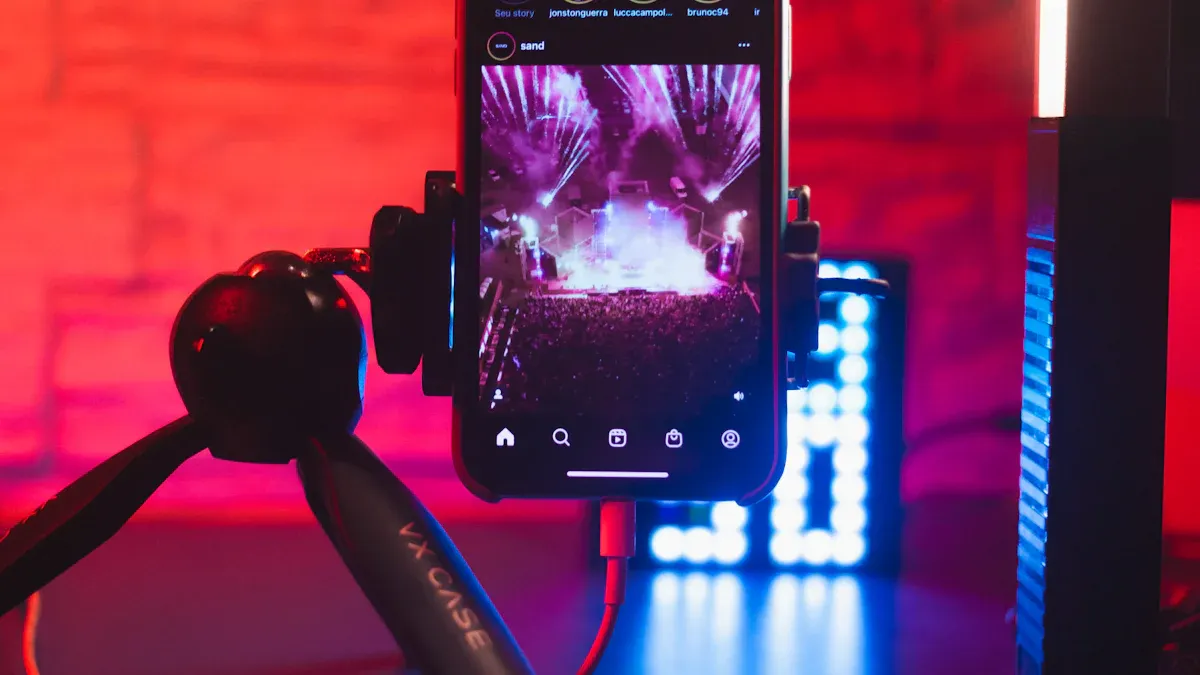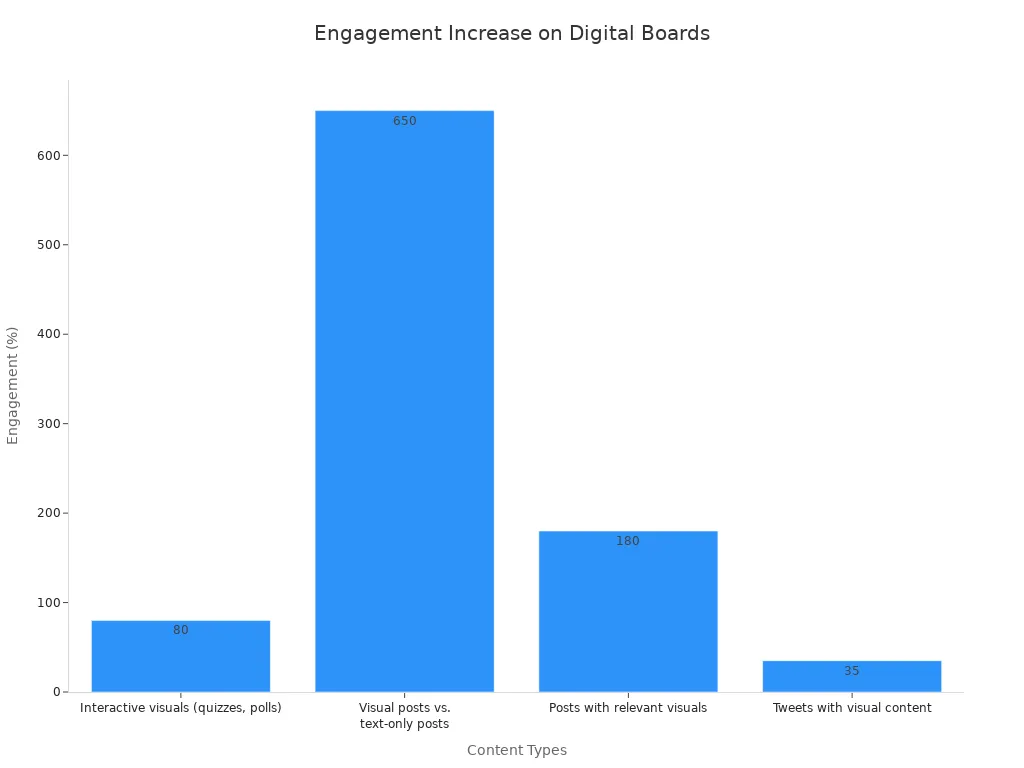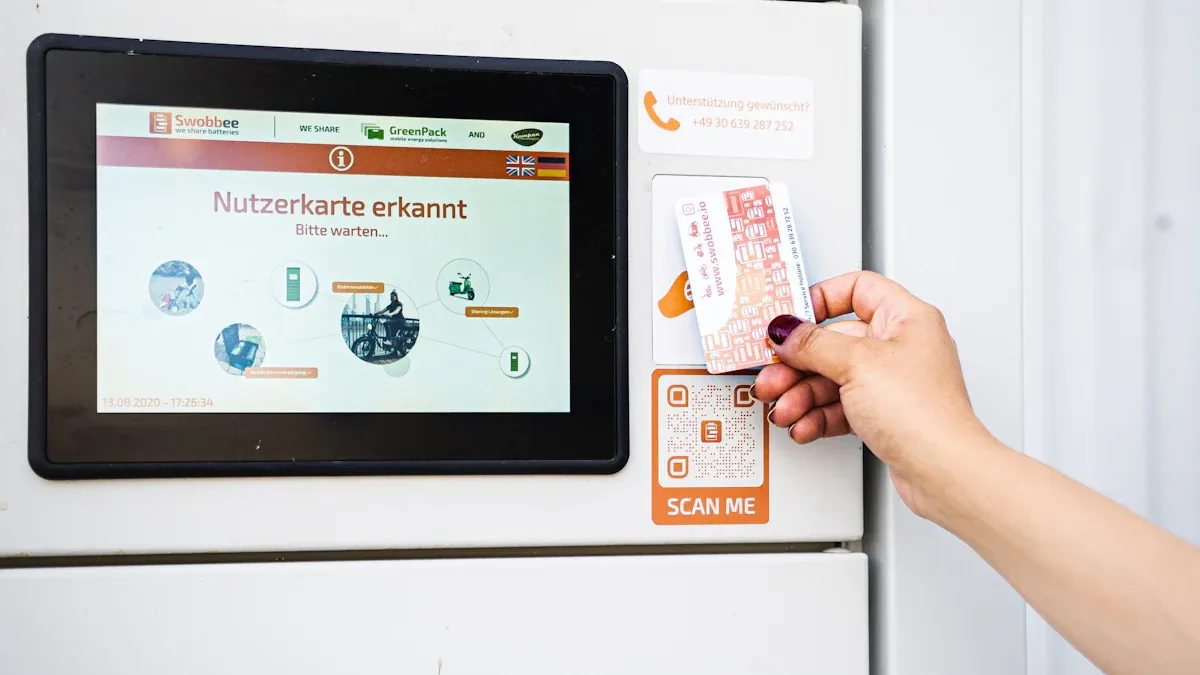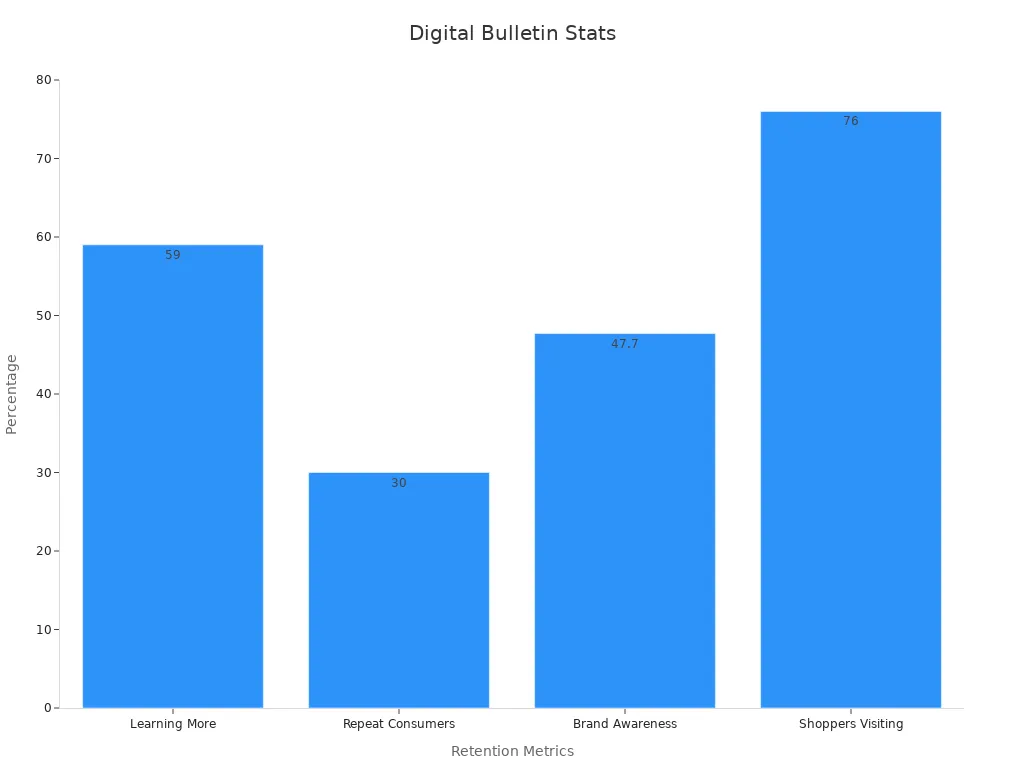How Bulletin Board Display Cases Are Evolving in the Digital Signage Era

You now see bulletin board display cases moving from static to dynamic digital signage. Digital bulletin board solutions use vivid images, videos, and multimedia content to make information more engaging. With touch screens and interactive features, you can share content that encourages participation and boosts communication. Recent data shows the U.S. digital signage market reached $6.38 billion in 2022. Digital bulletin board adoption has driven a 30% increase in community awareness. Schools, organizations, and community spaces use these tools to deliver information, share multimedia, and improve communication every day.

Key Takeaways
Digital bulletin boards replace paper notices with vibrant screens that show videos and images, making information more interesting and easier to update.
These digital displays allow quick, real-time updates and personalized messages, helping you reach the right audience at the right time.
Advanced technologies like LED, e-paper, and AI improve display quality, save energy, and make content management smarter and more interactive.
Using digital bulletin boards boosts engagement, helps people remember information longer, and reduces paper waste, supporting sustainability.
Schools, businesses, and community spaces benefit from digital signage by improving communication, saving time, and creating more connected environments.
Bulletin Board Display Cases: Then and Now

Traditional Display Cases
You may remember seeing bulletin board display cases in hallways, offices, or community centers. These displays use corkboards or glass cases to show printed flyers, posters, and announcements. You need to pin or tape paper notices to the board. If you want to update the information, you must remove old papers and add new ones by hand. This process takes time and can lead to outdated information staying on display. Traditional bulletin board display cases do not allow for interactivity. You cannot track who reads the information or how many people engage with the content. The displays reach everyone who passes by, but you cannot target specific groups or measure the impact.
Traditional signage limits your ability to share urgent updates quickly. You may also face printing costs and paper waste, which can add up over time.
Digital Bulletin Board Evolution
Today, you see a major shift from static bulletin board display cases to digital bulletin board systems. Digital bulletin board displays use LED or LCD screens to show high-resolution images, videos, and animations. You can update information instantly from a computer or mobile device. This means you can share real-time updates, event changes, or emergency alerts across multiple locations in seconds. Digital bulletin board signage allows you to schedule content, rotate messages, and even connect to calendars or social media feeds.
Digital bulletin board displays offer:
Interactive features, such as touch screens and feedback forms
Targeted messaging based on time, location, or audience
Centralized management for consistent information across all displays
Measurable engagement, including views, interactions, and dwell time
Studies show digital signage captures 400% more views than static displays. About 83% of people remember digital bulletin board content within 30 minutes. You can use digital bulletin board signage in schools, offices, hospitals, and public spaces. These displays help you reduce paper waste, save on printing costs, and improve accessibility for everyone. Digital bulletin board display cases make it easy to keep your information current, engaging, and relevant.
Digital Signage Tech Advances

LED and E-Paper Displays
You now have access to some of the most advanced digital signage displays ever created. High-resolution LED screens deliver bright, crisp images that grab attention in any environment. MicroLED technology takes this even further. MicroLED displays offer ultra-high resolution, superior brightness, and excellent energy efficiency. You can run these displays 24/7 without worrying about burn-in or fading. This makes them perfect for large video walls, luxury retail, and public spaces where you need reliable digital signage.
Color e-paper displays have also made huge leaps. E Ink Holdings' 'Gallery 4' technology now supports over 50,000 colors, a massive jump from earlier versions. Flexible and rollable e-paper displays, like LG Display's 13-inch rollable e-newspaper, give you new ways to design signage for unique spaces. E-paper uses about 1/100th the power of traditional LCD screens. This means you can keep your digital signage running longer while saving energy. The e-paper market continues to grow, with millions of units used in retail and logistics every year. These displays now offer better resolution, contrast, and durability, making them a smart choice for sustainable digital signage.
You can measure the impact of these displays with real data. Digital signage using LED and e-paper increases brand awareness by nearly 48%. Foot traffic can rise by 23%, and sales may jump up to 25%. Real-time updates and analytics let you track how people interact with your content, helping you make smarter decisions for your signage strategy.
AI and Content Management
AI is changing how you manage digital signage content. With AI-powered content management systems, you can automate updates, personalize messages, and analyze engagement in real time. AI helps you deliver the right content to the right audience at the right moment. For example, AI can adjust digital signage based on time of day, weather, or audience demographics. This makes your displays more relevant and engaging.
Recent market data shows that AI is now a key part of digital signage technology. Strategic partnerships, like LG Electronics USA and BrightSign LLC, are launching UHD digital signage displays powered by BrightSignOS with built-in AI. These systems use AI to optimize content, track engagement, and even predict what information will work best for your audience. AI personalization algorithms increase user engagement by extending session durations and boosting click-through rates. You can see these results in industries like streaming, e-commerce, and news, where AI-driven content leads to more interaction and better retention.
Tip: Use AI-powered content management to schedule real-time updates, target specific groups, and measure the effectiveness of your digital signage campaigns.
Interactivity and Mobility
Interactive displays are now a core feature of modern digital signage. You can use touch screens, QR codes, and even voice commands to let people interact directly with your content. Smart signage systems use AI and IoT to recognize users, adapt offers, and provide personalized experiences. For example, a digital sign can greet a customer by name, suggest products based on purchase history, or let users scan a QR code for instant discounts.
These interactive displays foster two-way communication. You move beyond simply showing information. Now, you invite your audience to participate, give feedback, and take action. Studies show that interactive digital signage improves brand attitudes and increases purchase intentions. Sensory-rich content, such as videos and animations, creates emotional connections and encourages people to engage with your displays.
Mobility is another important trend. You can manage digital signage from anywhere using cloud-based platforms. Real-time updates let you change content instantly across multiple locations. This flexibility helps you respond quickly to events, promotions, or emergencies. You save time, reduce costs, and ensure your messaging stays current and effective.
Key benefits of interactive and mobile digital signage:
Higher engagement and retention rates
Personalized content for different audiences
Faster, more accurate real-time updates
Improved data collection and analytics for better decision-making
Note: Privacy remains important. Always inform users about data collection and give them control over their information when using interactive displays.
Benefits of Digital Bulletin Board
Engagement and Retention
You want your audience to pay attention and remember what you share. Digital bulletin board displays help you achieve this goal. These displays use multimedia, such as videos, images, and animations, to make information more interesting. When you use multimedia content, you create enhanced engagement and help people remember your messages longer.
Digital bulletin board systems show clear benefits in both engagement and retention. You can see this in the numbers:
Metric Description | Numerical Evidence | Interpretation |
|---|---|---|
Students motivated to produce higher-quality work due to peer viewing | 67% agree/strongly agree | Shows increased engagement through peer accountability in video posts |
Students finding video explanations more effective than written | 44% agree/strongly agree | Shows better retention with video format over text |
Students spending more time on video discussion posts vs. written posts | Significant increase | Suggests deeper engagement with digital bulletin boards |
Students acknowledging the learning curve but valuing video skills | 67% agree/strongly agree | Reflects acceptance and long-term benefit of digital media skills |
You can also see how digital bulletin board displays improve communication and customer engagement in public spaces and businesses:
Statistic Description | Value/Percentage |
|---|---|
Recall rate of digital signage | 83% |
Increase in views compared to static displays | 400% |
Retention of visually presented information after 3 days | 65% |
Shoppers visiting business after viewing signage | 76% |
Brand awareness increase due to digital signage | 47.7% |
Increase in repeat consumer rates | Up to 30% |

You can use digital bulletin board displays to share announcements, event updates, and emergency alerts. These displays help you reach more people and keep their attention. When you use multimedia content, you make your communication more effective and memorable.
Tip: Use videos and animations to boost engagement and help your audience remember important information.
Customization and Relevance
You can tailor digital bulletin board displays to fit your needs. These systems let you change content quickly and easily. You can update announcements in real time, so your information always stays fresh and relevant. You can also use personalisation to show different messages to different groups at different times.
Here are some ways digital bulletin board displays offer customization and relevance:
You can display dynamic content, such as moving images, videos, and animations, to attract attention.
You can update content instantly, keeping announcements current.
You can choose fonts, colors, and layouts that match your brand or school style.
You can target messages to specific screens, locations, or times, reaching the right audience.
You can connect your digital bulletin board to data sources or social media feeds for real-time updates.
You can schedule content in advance and manage displays remotely for better communication.
When you use these features, you make your communication more effective. You reach the right people with the right message at the right time. This level of customization helps you improve engagement and keep your audience interested.
Sustainability
You help the environment when you use digital bulletin board displays. Traditional bulletin boards use paper, ink, and other materials that create waste. You need to print, post, and remove paper notices often. This process uses resources and creates trash.
Digital bulletin board systems reduce waste. You do not need to print new flyers or posters every time you have an update. You can change content on the screen with just a few clicks. Many digital bulletin board displays use energy-efficient technology, such as LED or e-paper screens. These displays use less power and last longer than older screens.
You also save money by reducing printing and supply costs. You spend less time updating displays, so you can focus on other important tasks. Digital bulletin board systems help you create a greener, more efficient way to share information.
Note: By switching to digital bulletin board displays, you support sustainability and help protect the environment for future generations.
Signage Use Cases
Education
You see digital bulletin board display cases in schools and universities every day. These displays help you share important information like class schedules, exam dates, and emergency alerts. You can update the information instantly, so students and staff always have the latest news. Teachers use digital boards to show videos, images, and interactive lessons. This makes learning more fun and helps students remember what they see. You can also use digital signage to highlight student achievements or promote school events. When you use these displays, you make communication clear and fast. Students know about events, changes, and important updates right away.
Business and Offices
You use digital bulletin board display cases in offices to improve communication and keep everyone informed. Digital signage lets you share real-time information, such as meeting reminders, policy changes, or IT updates. Research shows that using digital displays for internal communication can boost employee engagement and productivity by 25%. People remember 65% of visual information after three days, while they remember only 10% of what they hear. You can use interactive features like polls or quizzes to make communication more engaging. Centralized dashboards help you send the right information to the right office at the right time. You can also schedule messages for different shifts or locations. Built-in analytics show you which messages work best, so you can keep improving your communication strategy.
Tip: Use digital signage to reduce confusion and downtime by sending instant notifications about office closures or important events.
Community Spaces
You find digital bulletin board display cases in libraries, recreation centers, and city halls. These displays help you share community information, such as local events, public meetings, and safety alerts. You can update the information quickly, so everyone stays informed. Digital signage supports community information sharing and boosts community engagement. People see announcements about classes, volunteer opportunities, or emergency updates as soon as they walk in. In retail spaces, digital displays create immersive in-store experiences and help you promote sales or new products. Retail stores use digital boards to show real-time offers and guide customers to special events. When you use digital bulletin boards in community spaces, you make sure everyone gets the information they need, right when they need it.
You see digital signage transforming bulletin board display cases in every setting. These displays grab attention, boost engagement, and help you share updates instantly. You reduce waste and support sustainability by using energy-efficient screens. Features like touchscreens and voice narration make information accessible for everyone. Real-time updates keep your messages relevant. As you look for new ways to communicate, watch for the next wave of innovation in digital signage.
FAQ
What is a digital bulletin board display case?
A digital bulletin board display case uses a screen to show information. You can update content quickly. You do not need to print paper notices. You can share videos, images, and announcements in real time.
How do you update content on a digital bulletin board?
You update content using a computer or mobile device. You log in to a management system. You choose what to display and when. You can schedule updates or make changes instantly.
Are digital bulletin boards energy efficient?
Yes, many digital bulletin boards use LED or e-paper screens. These screens use less power than older displays. You save energy and reduce costs over time.
Can you use digital bulletin boards outdoors?
You can use special outdoor digital bulletin boards. These cases protect screens from weather and sunlight. You get clear, bright displays even outside. Always check for weatherproof ratings before installing.
See Also
Using Digital Signage To Effectively Present Information
Exploring Digital Signage Technology Benefits And Deployment Methods
How Digital Signage Technology Transforms Modern Communication
Customized Digital Signage Solutions For Retail Healthcare And Business

